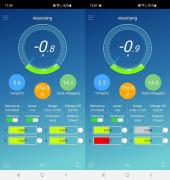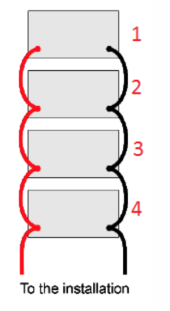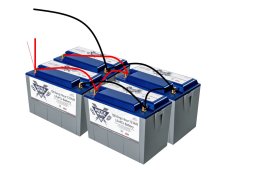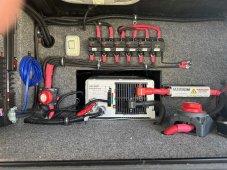you are too kind. thank you. yes, this problem does bother me very much. I don't want to put anyone through chapter and verse on my personal hells, but I am fighting a lot of battles due to age, infirmity and my responsibilities to others. I am not complaining or a complainer, and I am not a victim...but my plate is always full at a time when I wish I could slow down and were more able to accomodate the craziness around me....but it seems to be my karma that the oddest problems, et. al., are going to land on my doorstep, even as I try to outthink the world and stay one step ahead.
Anyway, I really appreciate this help.
I *think* the Trmetric always registered in lockstep (albeit one tenth of a volt less, per my email to another poster here) with what I was seeing elsewhere. I know not being sure, is not good enough, but the last time the trimetric was hooked up it began to...first time ever...suffer from an odd "pulsation" which even effected a few of the 12 volt lights inside the trailer.
after my "what else is going to happen" reaction, I realized by process, that it was not working right, and took the fuse out of line to shut it down.
I would like to suggest this is an important symptom, but both before it began to go odd, so to say, and afterwards, all the other symptoms existed and remain...and taking it off line stopped all that funny business with the lights...so my belief is that this may well have been a result of messing with the system to install the new batteries...maybe the fuse holder after sitting there for over 7 years.....but that it is not a central issue since disconnecting it did not change the main problem.
So in truth, I am not positive what it said at various times, as indeed, I never really paid a lot of attention to it, given that for 7 years, this system was working well.
I read your whole note and to the extent I am learning fast about all this.................also my tech is super and a good and honest man...and I am in the relative middle of nowhere, so such help is not readily avialable after him........is also now unwell with some serious, albeit curable issues...but I have not had him available to me in the interim and that has been a problem too as I have medical issues which make easy things not so easy for me, depending (among them five hand surgeries and that is not the worst of it so you can get the picture)...........................and as a person who is not unfamiliar with things "electric' although the trailer eco system has not been, from a learning perspective, my priority until recently....................to wit, I am an amateur radio operator for many years........everything you say makes completel sense to me.
that said, as mentioned previously in case it may have been lost in my volume of words, two sets of four BB batteries each have been tried here (I have 8 batteries in total) and all eight batteries...two sets of four....show the same issues when in the system....eliminating in my mind, the possibility of one BMS failure somewhere, etc.
IOW, fwiw, I agree with you on your analysis, but do not have a clue what that might be. i don't have a clamp on meter (my tech does...<sigh>...but fwiw, I do have a good fluke VOM. if the tech is not able to come here this week....I will ask him to lend me his...as I looked into this and a good one (fluke) is extremely expensive.....4 figures. that said, if you know of one which is acceptable in quality but not a couple of thousand...although at this point, I am prepared to do just about anything.....and can justify it with "who knows what the future holds", .....................I will do what I have to...so pse give me your opinion if you don't mind.
I have gone thru my mind, every appliance that I have in this box, and I just am seeing nothing which appears to indicate some problem which would be causing a constant load. indeed, as I have said, I have shut down the solar part of my life, simply to eliminate all I can, anything which might be causing an issue...and as you know from my total lack of brevity, here, I have tried two different 2812s, as well as two different magnum panels as well.
so I am on hold for a few more days in the meantime, waiting on my poor tech with his problems.......but that said, it has also been suggested that after hooking up the busbars...again, my sense, too, is that that won't change things but by process of elimination..............that i also try the CC/CV settings on the magnum.....so as I work through this list, I have that option as well.
as to your comment about bearing with you, please....don't think twice about that. I am literally grateful for the help here and the good news is that at the moment shore power is working, I am not in an emergency where I have to leave and take the trailer with me (my life circumstance, even at this age....in my 70s....is such that that remains a possiblity, although I hope I am done traveling......so for the moment, this is a nasty and elegant problem, but I am suriviving it, at risk of the appearance of melodrama in the way I put this.
so kindly take your time so you don't have my full weight on you

...and I am thankful in advance for all your thoughts...as well of all others.
this is a fine place to vet such things and every poster's responses have been fully welcome on this end...direct or not as the case may have been or be.
I will stand by for your comments about a clamp ammeter and then take steps to do something more.
thanks again.








